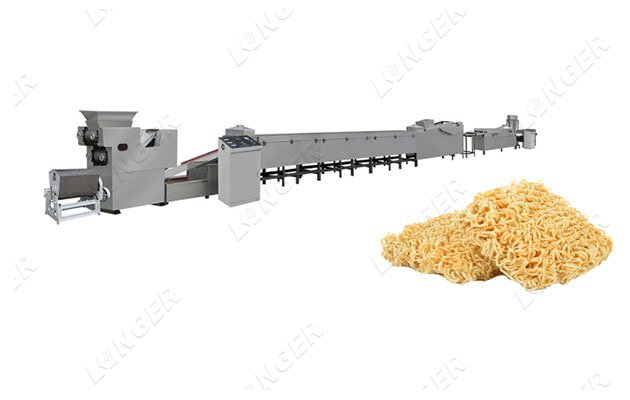Instant Noodles Production Process
2023-11-17
Instant noodles have become a staple in many households worldwide, offering a quick and convenient meal option. The production of instant noodles is a fascinating blend of culinary art and industrial science, involving intricate processes in a factory setting. But do you know the instant noodles production process?

Raw material preparation:
The process begins with the careful selection and preparation of raw materials. The primary ingredients include wheat flour, water, salt, and alkaline mineral salts. The flour is mixed with water to form a dough, and the alkaline salts are added to give the noodles their unique texture and taste. This mixture is then kneaded and rolled into thin sheets.
Steaming:
The thin sheets of noodle dough are steamed to partially cook them. This step is crucial in ensuring the noodles have the right texture and can be easily dehydrated for instant preparation. The steaming process also sets the shape of the noodles.
Cutting and folding:
After steaming, the sheets are cut into the desired noodle width. Depending on the noodle type, they may also be folded or crimped to create specific shapes and textures. This step requires precision to maintain consistency in the final product.
Frying or air-drying:
The noodles are then subjected to either frying or air-drying. Frying gives the noodles a crispy texture and extends their shelf life, while air-drying is a healthier alternative. The choice between the two methods often depends on the desired product characteristics.
Seasoning application:
Once the noodles are dried, they move to the seasoning application phase. This is where the flavor packets are added to the noodles. The seasoning can include a variety of ingredients such as salt, soy sauce, spices, and dehydrated vegetables. The precise measurement and distribution of these seasonings are critical to achieving consistent taste across batches.
Quality control:
Throughout the entire production process, rigorous quality control measures are in place. This includes sensory evaluations, laboratory tests, and visual inspections to ensure that the noodles meet the specified standards for taste, texture, and appearance.
Packaging:
After passing quality control, the noodles are ready for packaging. The packaging process involves sealing the noodles in individual servings along with the seasoning packets. The packaging not only protects the product but also serves as a marketing tool, with colorful designs and information about the product.
Distribution:
The final step in the factory is the distribution of the instant noodles to retailers and markets worldwide. This involves careful logistics and storage to maintain the quality of the product during transportation.
The production of instant noodles in a factory is a complex and highly controlled process that combines culinary expertise with industrial efficiency. From the careful selection of raw materials to the precision in seasoning and packaging, each step plays a crucial role in delivering the beloved and convenient instant noodles to households around the globe. If you want to built the instant noodle factory, contact us now.

Raw material preparation:
The process begins with the careful selection and preparation of raw materials. The primary ingredients include wheat flour, water, salt, and alkaline mineral salts. The flour is mixed with water to form a dough, and the alkaline salts are added to give the noodles their unique texture and taste. This mixture is then kneaded and rolled into thin sheets.
Steaming:
The thin sheets of noodle dough are steamed to partially cook them. This step is crucial in ensuring the noodles have the right texture and can be easily dehydrated for instant preparation. The steaming process also sets the shape of the noodles.
Cutting and folding:
After steaming, the sheets are cut into the desired noodle width. Depending on the noodle type, they may also be folded or crimped to create specific shapes and textures. This step requires precision to maintain consistency in the final product.
Frying or air-drying:
The noodles are then subjected to either frying or air-drying. Frying gives the noodles a crispy texture and extends their shelf life, while air-drying is a healthier alternative. The choice between the two methods often depends on the desired product characteristics.
Seasoning application:
Once the noodles are dried, they move to the seasoning application phase. This is where the flavor packets are added to the noodles. The seasoning can include a variety of ingredients such as salt, soy sauce, spices, and dehydrated vegetables. The precise measurement and distribution of these seasonings are critical to achieving consistent taste across batches.
Quality control:
Throughout the entire production process, rigorous quality control measures are in place. This includes sensory evaluations, laboratory tests, and visual inspections to ensure that the noodles meet the specified standards for taste, texture, and appearance.
Packaging:
After passing quality control, the noodles are ready for packaging. The packaging process involves sealing the noodles in individual servings along with the seasoning packets. The packaging not only protects the product but also serves as a marketing tool, with colorful designs and information about the product.
Distribution:
The final step in the factory is the distribution of the instant noodles to retailers and markets worldwide. This involves careful logistics and storage to maintain the quality of the product during transportation.
The production of instant noodles in a factory is a complex and highly controlled process that combines culinary expertise with industrial efficiency. From the careful selection of raw materials to the precision in seasoning and packaging, each step plays a crucial role in delivering the beloved and convenient instant noodles to households around the globe. If you want to built the instant noodle factory, contact us now.



 Message
Message